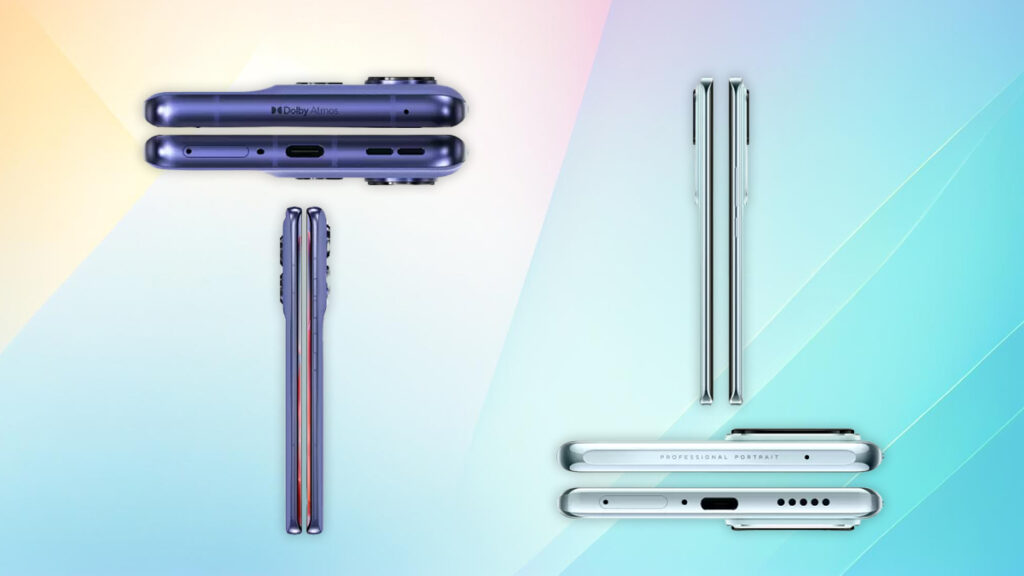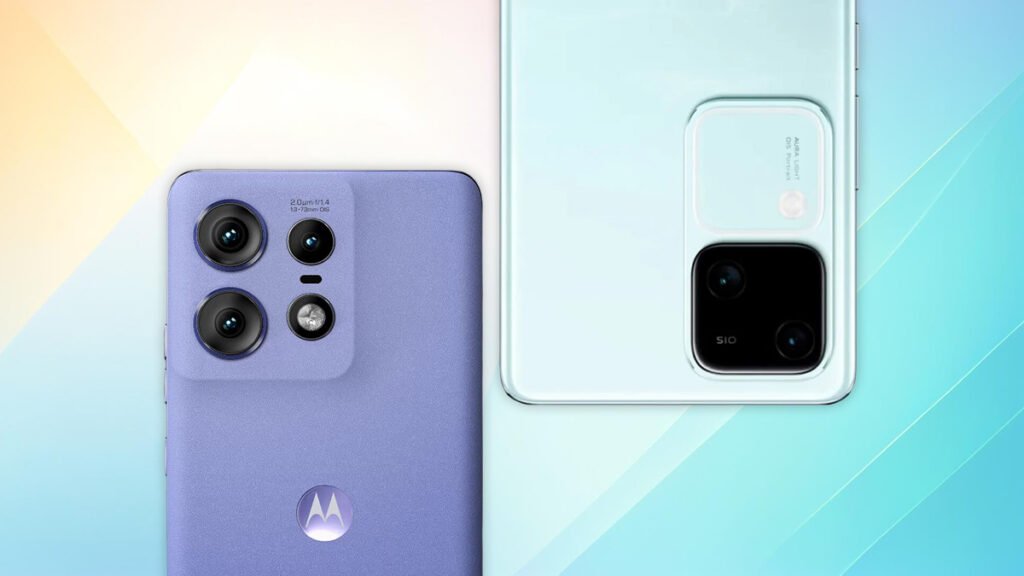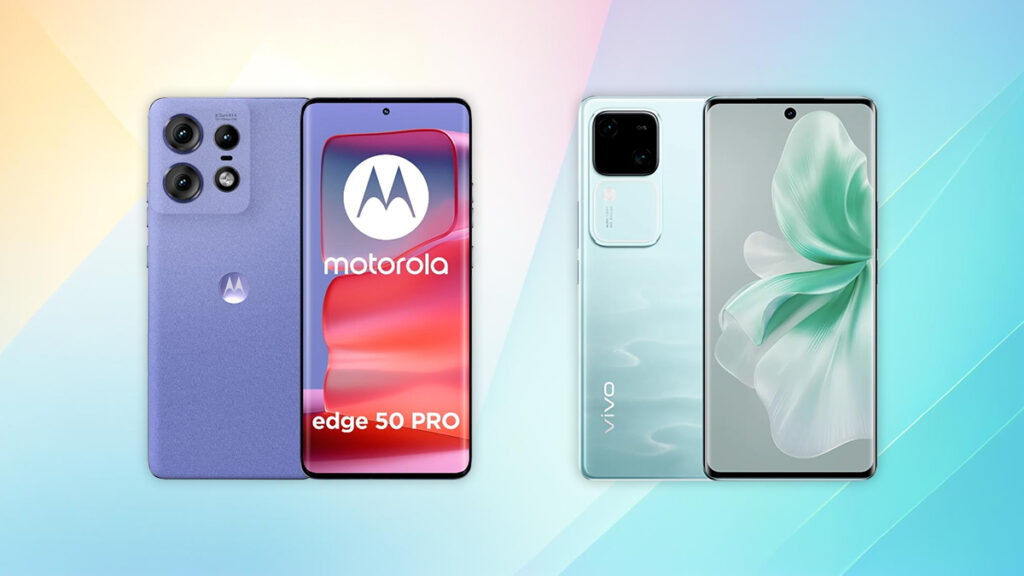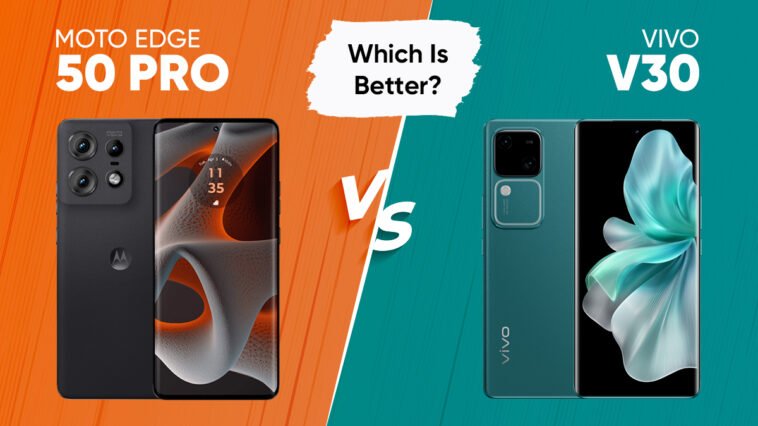In the bustling arena of mid-range smartphones, the clash between Moto Edge 50 Pro vs Vivo V30 exemplifies the balance of innovation, design, and value that today’s consumers crave. With its lifestyle-centric appeal, the Motorola Edge 50 Pro offers a splash of color approved by Pantone and a suite of features aimed at enhancing the sensory experience of its users. On the other hand, the vivo V30, a beacon in Vivo’s photography-oriented lineup, promises a sleek design and powerful performance tailored for shutterbugs.
Both devices boast impressive specs and unique selling points, setting the stage for a head-to-head comparison to determine which phone truly stands out in this competitive market. In this blog post, we will delve into their specifications, camera capabilities, pricing, and design to see which smartphone might be the better choice for you.
Specifications Comparison: Moto Edge 50 Pro vs Vivo V30

When choosing a smartphone, specifications often play a critical role in decision-making. Let’s dive deep into the technical details of the Moto Edge 50 Pro and Vivo V30 to see how they stack up against each other.
Display and Resolution
- Moto Edge 50 Pro: It features a 6.7-inch P-OLED display with a resolution of 1220×2712 pixels, boasting a peak brightness of 2000 nits and a refresh rate of 144Hz. The display also supports HDR10+ for HDR playback. Moreover, the display can reach 1200 nits in auto brightness mode.
- Vivo V30: This device comes with a 6.78-inch AMOLED screen, slightly larger than the Motorola, with a resolution of 1260×2800 pixels. It also supports HDR10+ and has a high brightness level of 2800 nits (peak) and a refresh rate of 120Hz. Moreover, the Vivo V30 display can also reach 1200 nits in auto brightness mode.
The Vivo V30 edges out slightly in peak brightness, providing potentially better, brighter HDR video playback. At the same time, the Moto Edge 50 Pro offers a higher refresh rate for smoother scrolling and gaming experiences. However, the Moto Edge 50 Pro doesn’t support HDR playback on Netflix, but it supports HDR 10 and HDR 10+ playback on YouTube, while the Vivo V30 supports HDR playback on Netflix and all other platforms.
Chipset, RAM, and Storage
- Moto Edge 50 Pro: Powered by the Qualcomm Snapdragon 7 Gen 3 chipset, configurations include 8GB or 12GB of RAM and a single storage option of 256GB. This setup places it solidly in the upper mid-range segment.
- Vivo V30: Equally equipped with the Snapdragon 7 Gen 3, the Vivo V30 offers similar RAM options (8GB and 12GB) and the storage variations of 128GB and 256GB.
Both devices are very similar in processing power and memory, which means they will provide comparable performance levels for daily activities and gaming. However, the Moto Edge 50 Pro has a clear advantage as it offers 256GB of storage with every version, regardless of which version you buy.
Camera Capabilities
- Moto Edge 50 Pro: This model boasts a versatile three-camera setup, featuring a 50 MP main camera with f/1.4 aperture, a 10 MP telephoto lens with 3x optical zoom, a 13 MP ultra-wide lens, and a 50MP selfie camera with autofocus. The main also includes advanced features like multi-directional PDAF, Laser AF, and OIS.
- Vivo V30: On the rear, the Vivo V30 sports a dual camera system with 50 MP sensors—one for the primary camera (wide) and one ultra-wide. It lacks a dedicated telephoto lens but includes OIS and AF for video stabilization and sharp images.
The Motorola Edge 50 Pro offers a more diverse camera array, which might appeal to those looking for flexibility in photography, from portraits to wide landscapes. In terms of camera and video quality, the Motorola Edge 50 Pro and the Vivo V30 have different strengths. The Edge 50 Pro performs slightly better in camera performance, while the V30 provides much better video quality. However, In low light, Vivo V30 captures better images.
Battery Life and Charging
- Moto Edge 50 Pro: It houses a 4500mAh battery, supporting 125W wired charging—capable of reaching full charge in just 18 minutes—and 50W wireless charging. Keep in mind though; the 8GB variant only comes with 68W wired charging.
- Vivo V30: The Vivo V30 is equipped with a larger 5000mAh battery, supporting 80W fast charging that can fully charge in about 48 minutes, but lacks the more advanced wireless charging capabilities of the Motorola.
While the Vivo V30 offers a larger battery, potentially providing longer usage, the Moto Edge 50 Pro excels in charging technology, presenting a significant advantage for users needing quick recharges and the convenience of wireless charging.
Other Features
Both phones are comparable in additional features such as connectivity options—supporting 5G, Wi-Fi 6, and Bluetooth 5.4. However, Vivo V30 lacks NFC. They also run on Android 14, ensuring a modern software experience. The Motorola Edge 50 Pro has a slightly higher edge with an IP68 rating for water and dust resistance compared to the IP54 rating of the Vivo V30, making it more durable under various environmental conditions.
Camera Features: Moto Edge 50 Pro vs Vivo V30

A smartphone’s camera capabilities are often a decisive factor for many users. We’ll compare the camera features of the Moto Edge 50 Pro and the Vivo V30 to see how they measure up, particularly for those who are photography enthusiasts.
Moto Edge 50 Pro Camera Setup
- Main Camera: The Moto Edge 50 Pro features a 50 MP wide-angle camera with a large f/1.4 aperture, which allows more light to hit the sensor, improving low-light performance. It also supports multi-directional Phase Detection Autofocus (PDAF), Laser Autofocus (AF), and Optical Image Stabilization (OIS), ensuring sharp images and steady videos.
- Telephoto Lens: The inclusion of a 10 MP telephoto lens with a 3x optical zoom offers versatility, allowing users to capture distant subjects without losing clarity.
- Ultra-Wide Lens: A 13 MP ultra-wide lens with autofocus adds to its array of capabilities, enabling expansive landscape shots and creative perspectives.
- Selfie Camera: The Moto Edge 50 Pro features a powerful 50 MP front-facing camera. It features an aperture of f/1.9 and a 21mm lens, allowing for wide and clear selfies. This setup also includes autofocus, which is a handy feature for maintaining a sharp focus on the object and ensures that selfies are detailed.
- Video Capabilities: The device can record up to 4K video at 30 fps, with support for 1080p at higher frame rates for slow-motion effects. It also features 10-bit HDR10+ video recording, enhancing color depth and dynamic range.
Vivo V30 Camera Setup
- Wide and Ultra-Wide Cameras: The Vivo V30 offers a dual 50 MP setup for both its primary and ultra-wide cameras. The primary wide-angle camera has an aperture of f/1.9 with PDAF and OIS, ensuring good performance in various lighting conditions. The ultra-wide camera also features autofocus, which is only sometimes common and is beneficial for sharp, wide shots.
- Selfie Camera: Unique to the Vivo V30 is its impressive front-facing camera with auto focus. It sports a 50 MP sensor with a wide-angle lens and autofocus, making it a superior choice for selfie enthusiasts and vloggers.
- Video Capabilities: Like the Moto Edge 50 Pro, the Vivo V30 can shoot 4K video at 30 fps. Its gyro-EIS (Electronic Image Stabilization) helps keep video footage stable.
Comparison and Use Cases
- Low-Light Photography: The Moto Edge 50 Pro’s main camera with a f/1.4 aperture might edge out the Vivo V30 in low-light environments, capturing clearer and brighter images under challenging lighting conditions.
- Versatility in Zoom: The Moto Edge 50 Pro’s telephoto lens with optical zoom is a significant advantage for users interested in wildlife photography or capturing details from afar.
- Wide-Angle Shots: Both phones perform well with their ultra-wide lenses; the autofocus on both ultra-wide cameras is a plus. However, the Vivo V30 maintains consistency by offering 50 MP on both its primary and ultra-wide sensors.
- Video Bloggers and Selfie Lovers: The Vivo V30 could be more appealing to vloggers or those who frequently use the front camera for selfies or videos, given its high-resolution front camera with autofocus. Additionally, the Vivo V30 videos have good dynamic range, noise free, and have good video stabilization.
Price Analysis: Moto Edge 50 Pro vs Vivo V30
When evaluating smartphones, price is a crucial factor that can significantly influence a decision. Let’s compare the pricing of the Moto Edge 50 Pro and the Vivo V30 to determine which offers better value for money based on their features and performance.
Moto Edge 50 Pro Pricing
- The Moto Edge 50 Pro is positioned as an upper-midrange device, reflecting its sophisticated specifications and features. While official pricing can vary by region, it typically falls within a competitive range that attempts to undercut flagship devices while offering similar levels of performance and features. In India, the price for the base model (256GB/8GB RAM) typically starts around ₹31,999.
- The higher variants, especially the ones with increased RAM, such as the 256GB/12GB configuration, can see prices approaching or slightly exceeding ₹35,999, positioning it close to premium flagship territory but still generally more affordable compared to high-end models from brands like Apple and Samsung.
Vivo V30 Pricing
- The Vivo V30, similar to the Moto Edge 50 Pro, is aimed at the upper-midrange market segment. It is often priced slightly higher than the Motorola, making it an appealing option for budget-conscious buyers. The starting price for the Vivo V30 in India is typically around ₹33,999 for the base model.
- Like its competitor, the price increases with higher storage and RAM options. However, the top-tier Vivo V30 model usually caps out at around ₹37,999, making even its most expensive variant slightly higher than the top offering of the Moto Edge 50 Pro.
Design and Build Quality: Moto Edge 50 Pro vs Vivo V30

Design and build quality are pivotal factors that not only influence the aesthetic appeal of a smartphone but also its durability and user experience. Let’s evaluate the design elements and construction quality of the Moto Edge 50 Pro and the Vivo V30 to determine which device better suits your preferences.
Moto Edge 50 Pro Design and Build Quality
- Materials: The Moto Edge 50 Pro features a sophisticated design with a choice of materials, including a glass front, silicone polymer (eco-leather), or acetate back, and an aluminum frame. This selection not only contributes to the device’s premium feel but also to its durability.
- Dimensions and Weight: It measures 161.2 x 72.4 x 8.2 mm and weighs 186 grams, making it a device that balances size and weight for a comfortable hold.
- Water and Dust Resistance: One of the standout features is its IP68 rating. It is highly resistant to water and dust ingress, providing peace of mind for users in varied environmental conditions.
- Aesthetic Features: The collaboration with Pantone for color options like Luxe Lavender adds an exclusive touch, and the device’s overall design is tailored to appeal to users looking for functionality and style.
Vivo V30 Design and Build Quality
- Materials: The Vivo V30 also uses premium materials, including a glass front and back with a plastic frame, which gives it a sleek, modern look while being slightly less robust compared to metal-framed devices.
- Dimensions and Weight: This model is slightly thinner and has similar dimensions at 164.4 x 75.1 x 7.5 mm; it also weighs 186 grams, closely matching the Moto Edge 50 Pro in terms of handling and pocketability.
- Water and Dust Resistance: It comes with an IP54 rating, offering limited protection against dust and splashing water, making it less suited for more demanding environmental conditions than the Moto Edge 50 Pro.
- Aesthetic and Practical Design: The Vivo V30 presents a dual-glass design emphasizing its aesthetic appeal, aimed at users who prefer a sleek and stylish appearance without needing higher durability ratings.
Comparison and User Impact
- Durability: The Moto Edge 50 Pro, with its aluminum frame and higher IP68 rating, is likely to endure rougher conditions better than the Vivo V30. It suits users who may expose their phones to moisture, dust, or accidental drops.
- Ergonomics and Handling: Both devices are designed with attention to ergonomics, featuring sizes and weights that are typical for today’s larger smartphone models, ensuring they remain comfortable to hold and use over extended periods.
- Visual Appeal: While both models offer unique color options and a high-end feel, the Pantone collaboration on the Moto Edge 50 Pro may attract users looking for a distinctive design flair, whereas the Vivo V30’s elegant dual-glass construction will appeal to those valuing a minimalist and modern aesthetic.
FAQs: Moto Edge 50 Pro vs Vivo V30
The Vivo V30 features a glass back. This design choice gives it a premium look and feel, although it might be more susceptible to fingerprints and smudges than other materials.
The Vivo V30 is equipped with a single bottom-firing speaker. While it lacks stereo sound, it is designed to be sufficiently loud for everyday use, though it may not match the audio depth that stereo speakers provide.
The pricing of the Vivo V30 5G in India in 2024 typically starts around ₹33,999 for the base model. However, prices vary based on regional offers, sales, and spec variations like RAM and storage options.
The Motorola Edge 50 Pro 5G is not entirely waterproof but does have an IP68 rating, which means it is highly resistant to dust and can handle submersion in water to a certain depth (up to 1.5 meters for up to 30 minutes), making it very durable against water-related accidents.
Yes, the Motorola Edge 50 Pro 5G supports wireless charging. It offers up to 50W wireless charging capabilities, which is a significant improvement over previous generations and adds a level of convenience for recharging the device.
Also Read: Oneplus 12 vs Vivo X100: Which One Should You Buy?




Comments
Loading…